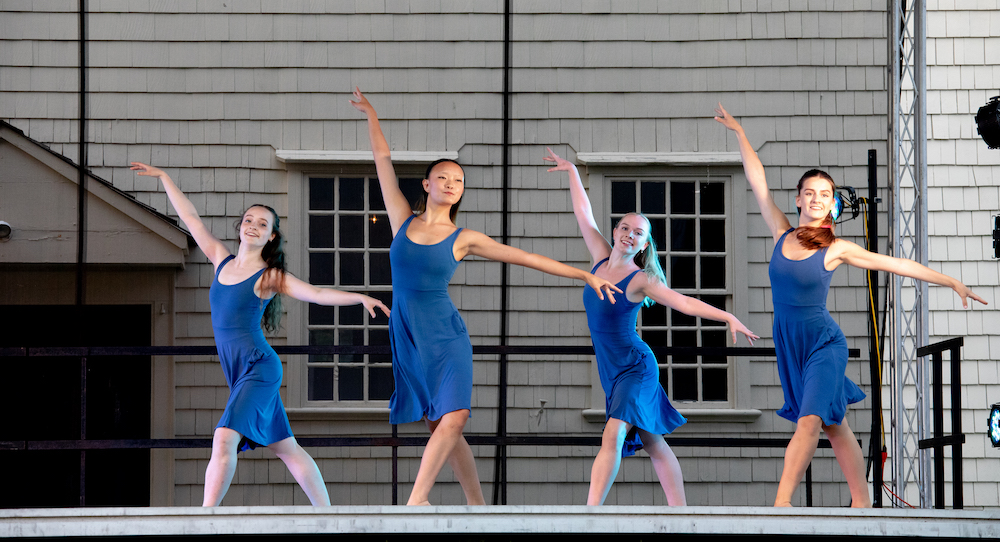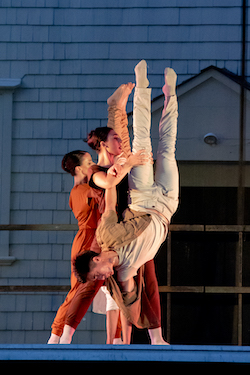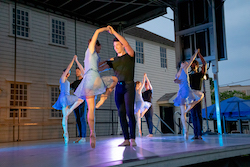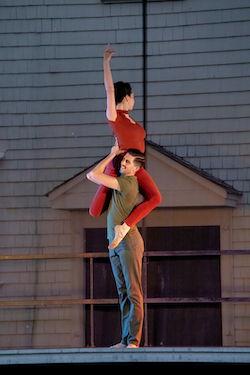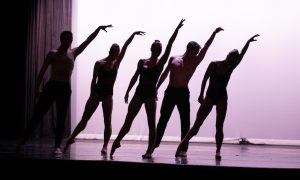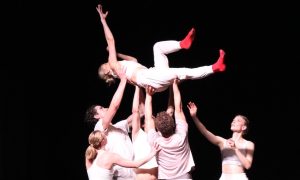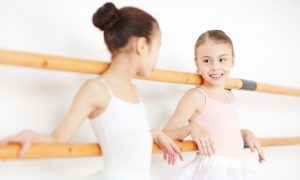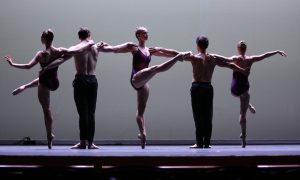The lawn at the Great Friends Meeting House, Newport, RI.
July 20-25, 2021.
As was the case with most dance events last year, Island Moving Company (IMC) had to cancel the 2020 Newport Dance Festival. Through the annual festival (formerly the Great Friends Dance Festival), the Newport, RI-based contemporary ballet company aims to spur creative generativity, support other small to medium-sized companies, and build connections between dance artists and organizations across the country and across the world.
Each year, a select company works with IMC to create new work, and share repertory work, in a two-week residency period leading up to festival performances. As another structure of creating under constraint, company artists also have the opportunity to create a short “étude” (or study, a sort of work-in-progress) on their peers — in just two hours. Can limitations, whether intentional or the product of practicalities, be creatively generative? Artists and audience members of the festival can find out!
Regarding this year’s festival: to be clear, we’re not done with COVID, yet large-scale vaccination has allowed us (under certain safety constraints) to nevertheless come together for dance again — to create, enjoy and support it. In the face of those existing constraints, and all of the challenges that artists have juggled over the course of this pandemic, the artists involved with this year’s Newport Dance Festival offered something truly magical and memorable.
Performances took place on an outdoor stage, audience members spread out in lawn chairs over lush grass in front of it. A slight chill and cloudy skies on the Wednesday night of the festival, juxtaposed against the beauty gracing the stage, had me thinking about wonderful things happening in the face of limitations.
The following works were most memorable and enjoyable to me personally. Also presented were IMC dancer Deanna Gerde’s thoughtful étude speaking to our relationships with others and ourselves; Khambatta Dance and IMC dancing Cyrus Khambatta and the company’s Excerpts from Endangered Species and Crowd Control (abstract, with a pared down aesthetic, but nonetheless revealing so many colors of human interaction); East Coast Contemporary Ballet’s The Last Leaves (which thoughtfully embodied calm and strength amongst frenetic forces); and IMC’s A Party in My Mind (a light and at times comical party of a ballet piece — a great choice for a program closer, leaving audience members with a smile and a feeling of lightness).
IMC and Malashock Dance performed John Malashock and Tristian Griffin’s Suite from THE BRIDGE second in the program. Although it can be challenging to glean a wider comprehensive meaning or quality of any work from excerpts alone, what was presented spoke to understanding — or lack thereof — between humans (in pairs or in larger groups). Raw, inventive physicality and clever structuring of bodies into a stage picture, all of which the dancers commendably delivered, translated these themes. To begin the piece, dancers walked out in pairs — eyeing each other, a feeling of contention in the air. Some of that contention softened as the dancers paired off: sharing weight, coming in and out of each other’s kinespheres, leaving and returning to unison timing.
A memorable motif (also repeated later in the work) was dancers quickly switching from back-to-back to facing each other and touching palm-to-palm — impressive as something that seems to require impeccable timing to accomplish. Together, all of this movement vocabulary and structuring spoke volumes about dynamics within close relationships. Simple costumes, in pedestrian cuts and natural hues (forest greens, blacks, dark earth tones) infused a realistic feel to those dynamics — and allowed the movement to draw the most focus (costumes by Jemima Dutra). A catchy percussive score (by Philip Daniel Zach) supported interesting accents in the music, offering something satisfying to multiple senses.
As the piece continued, movement vocabulary added further perceptiveness on what happens between humans — and was simply aesthetically excellent. Legs suspended à la seconde (to the side) again and again spoke to behavioral patterns. At times, the movement took on a mechanical quality, pointing to the lack of thoughtfulness that can allow such patterns to continue when they don’t serve us or those in our lives.
At other times, limbs moved in opposition, in conversation with each other — as if having a mind of their own, like the independently intelligent limbs of an octopus — even while the dancers moved from an intentional, grounded core center. Indeed, parts of ourselves can be in tension with each other, even while we appear outwardly integrated and harmonious. Intelligent, deliberate structuring of dancers across the stage space continued speaking to further group dynamics, and simply kept it all visually crisp.
Toward the end, a powerful unison section — complete with lifts of true support and cohesion — demonstrated cooperation toward a common goal. I thought about cooperation and harmony, how dancers of two different companies danced together with true physical intelligence and receptiveness — making the fact that they were two different companies only dancing together in the past week or so not really evident.
As the piece closed and the dancers took their final bow, I also reflected on the title in relation to movement and structural choices within the work; what can build “bridges” to understanding, connection, and harmony between us? How much of that can be found through the body itself? That’s certainly meaningful food for thought!
Later, East Coast Contemporary Ballet presented Alejandro Ulloa’s Just for You — a solo with an elegant and presentational quality but also an intriguing sense of thoughtful inquisitiveness. The movement, which the soloist Claire Mazza executed commendably, had a smooth and lovely blend of classicism and more contemporary ingenuity of shape.
One memorable gesture within that ingenuity was a drawing of one hand across her face, as if looking inward and discovering what’s there. A repeated movement of reaching and circling her torso brought a sense of exploring outward. The harmonious instrumental score (by Claude Debussy) infused positivity to this exploration — a happy asking and discovering rather than a desperation and coming upon hard truths. Mazza’s presence was uplifted and joyful to match. As such, the piece left me feeling that same happy desire to search and to discover.
Then came students of IMC’s Summer Intensive dancing Valerie Robertson’s Renascence. It was an uplifting painting in dance of what it feels like to safely gather in space together again. The four dancers danced with a carefree, childlike joy, their smiles easy and their movement light — a feeling which their simple thigh length dresses and bows in their half-up hair complimented.
The movement had an Esplanade sense of continuous and joyful locomotive movement — although also with technically challenging leaps and turns galore. The score, a cover of the Beatles song “Here Comes the Sun” from Richie Havens, truly brought the emotional meaning home. “It’s been a long time, lonely winter…and I say, it’s alright” — what words for this time, to truly tug at the heartstrings!
Also resonant in the piece was how the four dancers at times danced individually, at times together — finding both commonality and individuality, and their own nurturing blend of both. That’s something that we can all strive for!
As a highlight of Saturday night’s program, IMC and Malashock Dance once again came together for Malashock’s Swells — a work reflecting the natural world and bringing an overall peaceful feeling. The dancers started facing upstage, in a line at the wings. With the score’s gentle piano strokes, they glided sideways toward center stage — in and out again like the rhythm of breath.
Interlocking of their lines reminisced tangled wildflowers, reaching for the sun’s nourishment in different directions, or even the locking of chemicals within the muscular cell of a human or animal — the rhythms of nature. Graceful, light lifts of their arms, matching the lightness of their sideways gliding, felt like being gently lifted in a slight breeze. Their forest green costumes, simply cut to flow just so with the dancers’ curvilinear movement, deepened the sense of the natural world at hand.
The score built in intensity and volume, bringing my mind to a windy, temperate sunset when my mind is called to reflect, to dream, to pine, to ponder. Formations moved into clumps — groups juxtaposing and dancers in pairs coming to support each other’s weight. Through subsequent formations and groupings, characterizations and social dynamics built — tensions, passions, proximity and release.
Concentric circles took the stage toward the end of the piece, in formation shifts too smooth to see coming. Once again, I thought of natural harmony — orbiting, solitude and coexistence. Lovely turns and lines pleased the eye and the spirit. A crescendoing section toward the end built toward a final formation — an organized clump (as one might describe it, or perhaps tightly-packed lines), dancers gesturing in unison.
The gesture executed in that formation — a hand on a hip and the other reaching to the ground, bent halfway over at the waist — brought American football to mind for me, and felt a bit out of place and incongruent to the rest of the piece. In truth, so much of the piece was memorably satisfying and well-crafted, so I didn’t think much of it — and it certainly can be hard to see how something does or doesn’t compliment the work as a whole in such a short rehearsal process.
For this piece and all else presented in 2021’s Newport Dance Festival, brava to all involved collaborators for offering commendable, pleasing works in the face of constraint and challenge. Artists know how to make the best out of limitations, and — like diamonds borne from pressure — beautiful things can emerge from those efforts.
By Kathryn Boland of Dance Informa.


